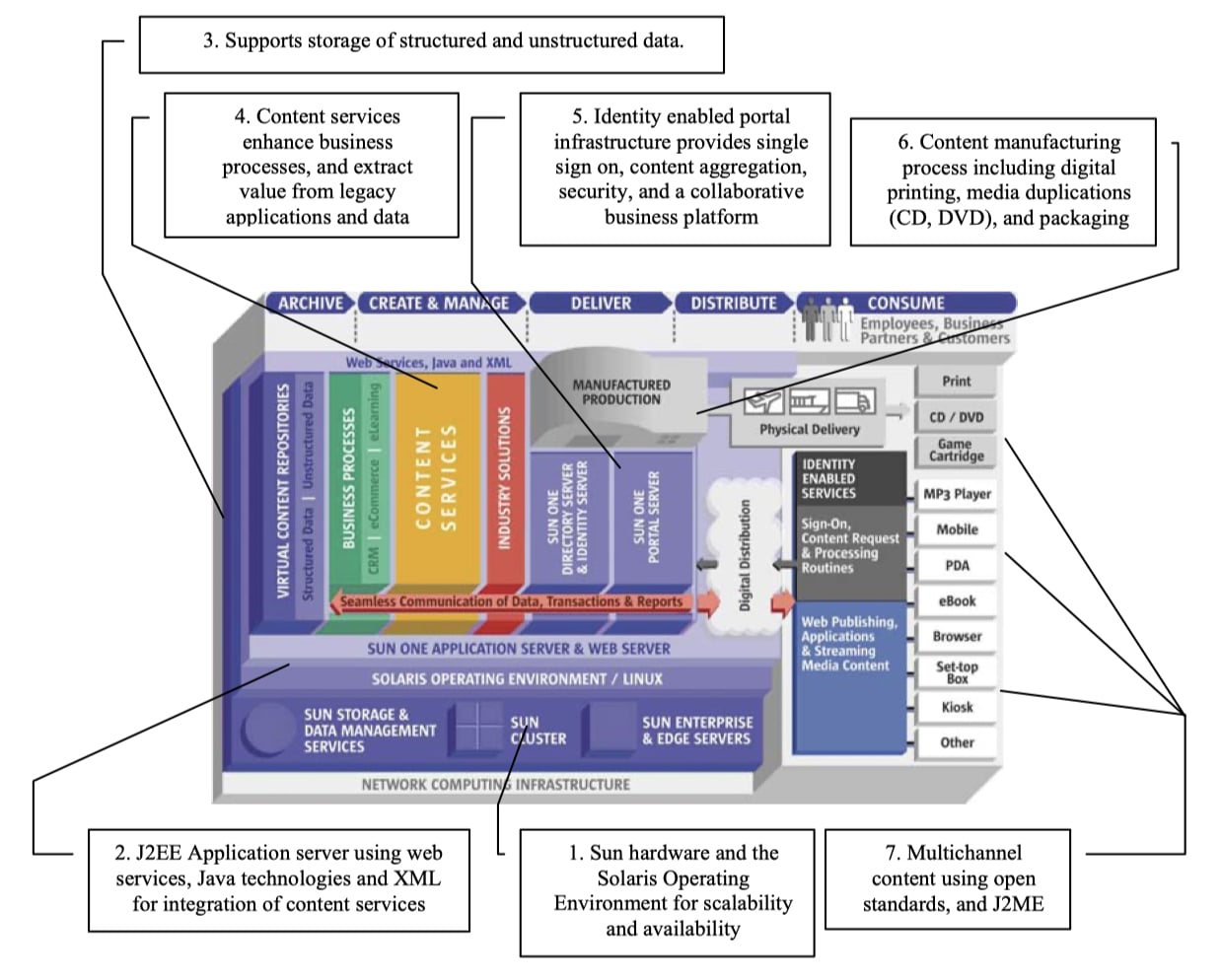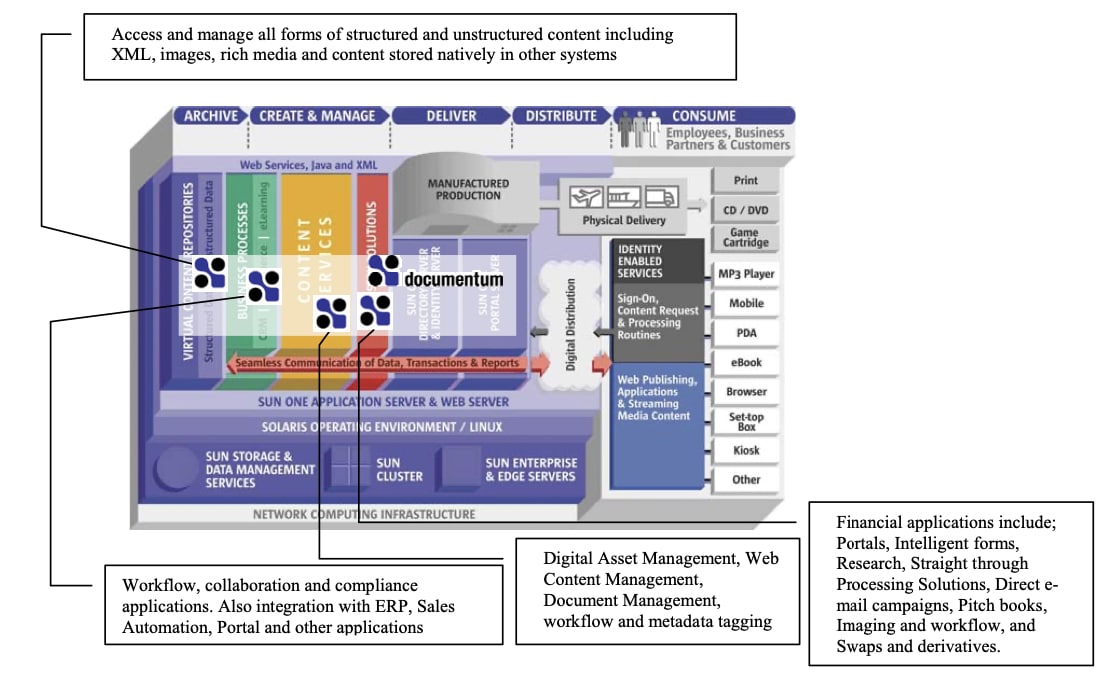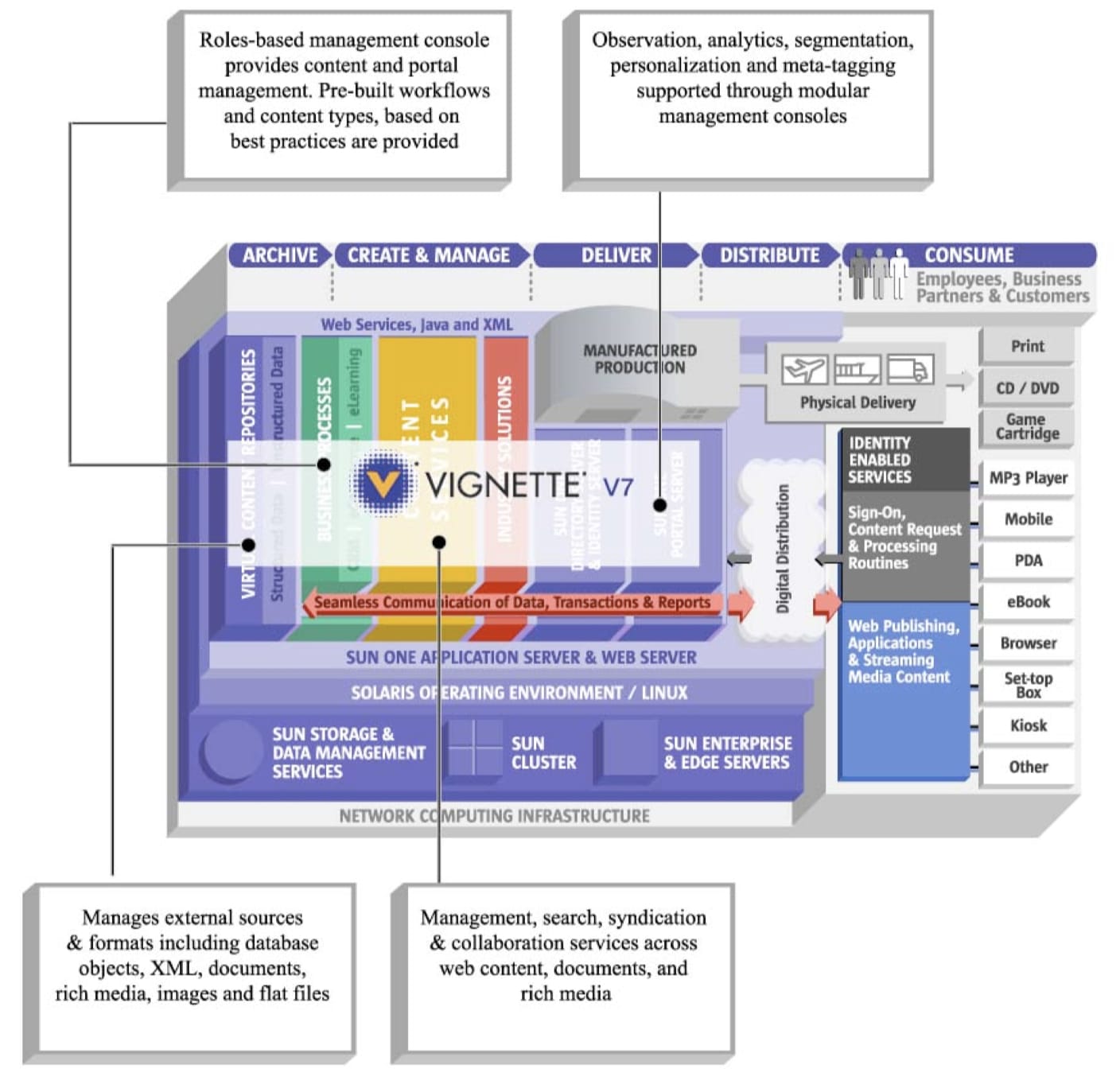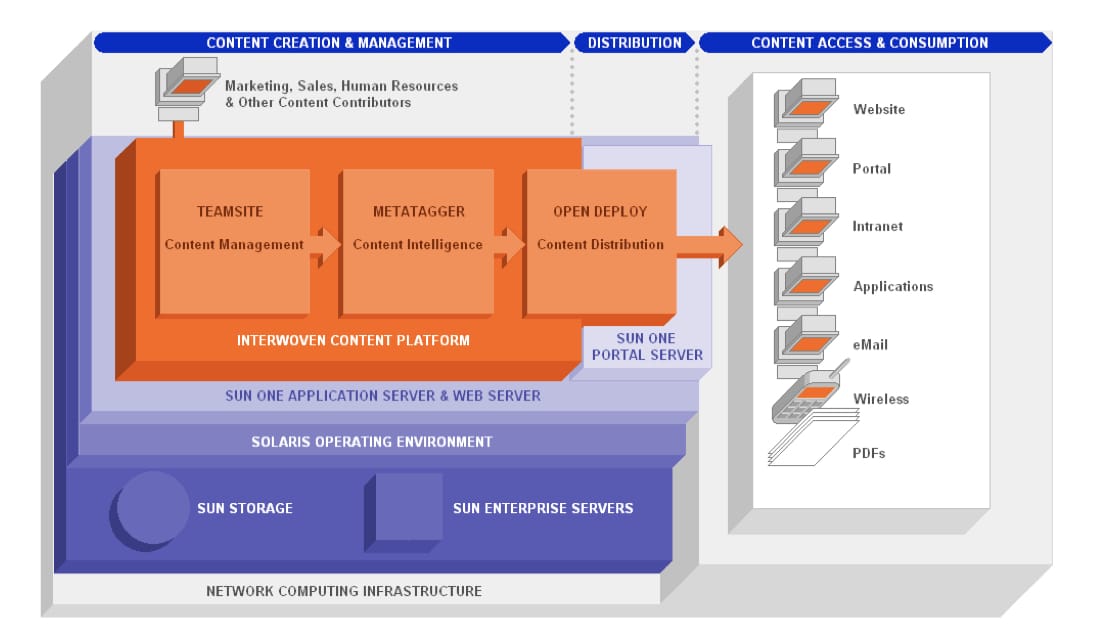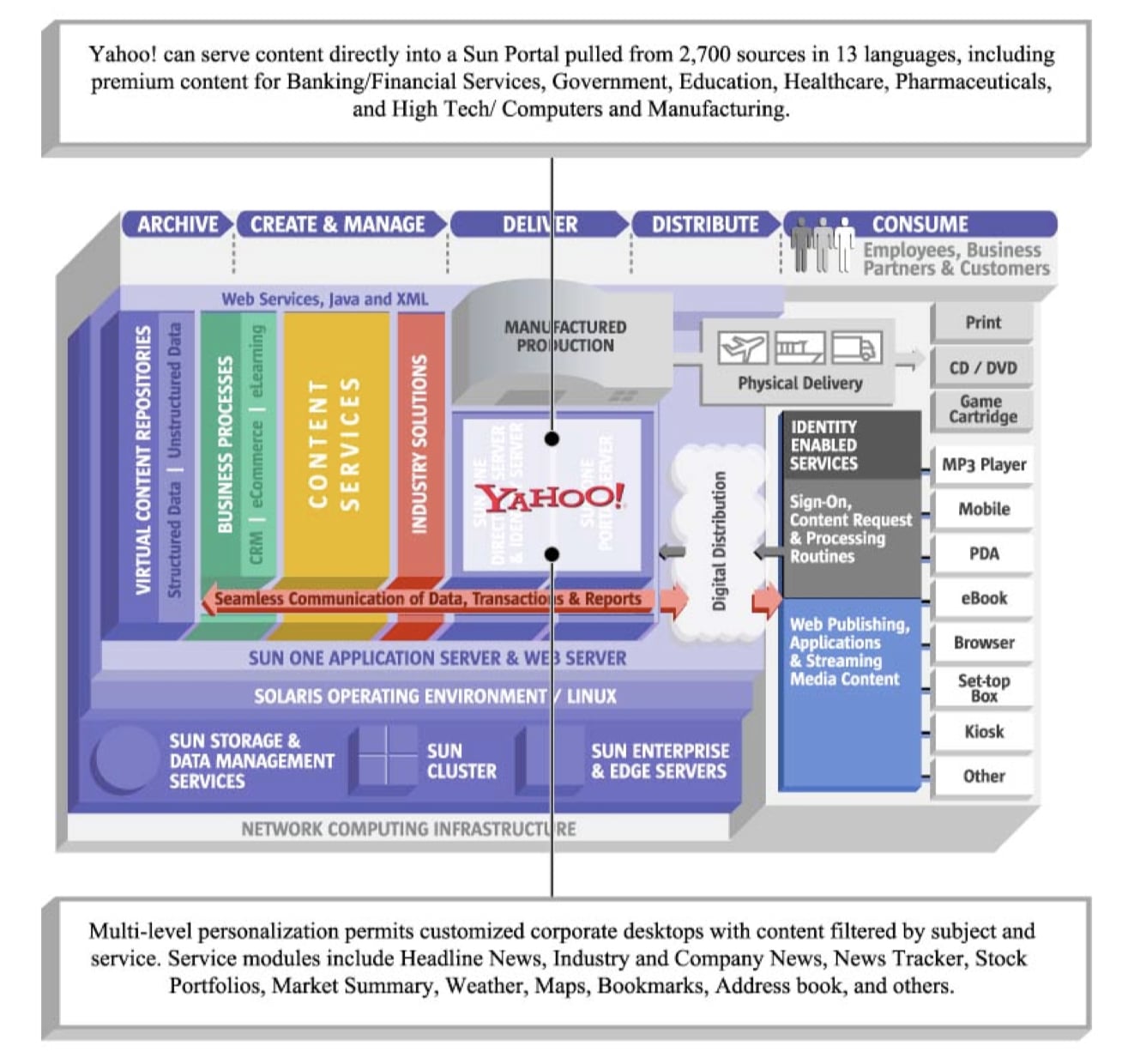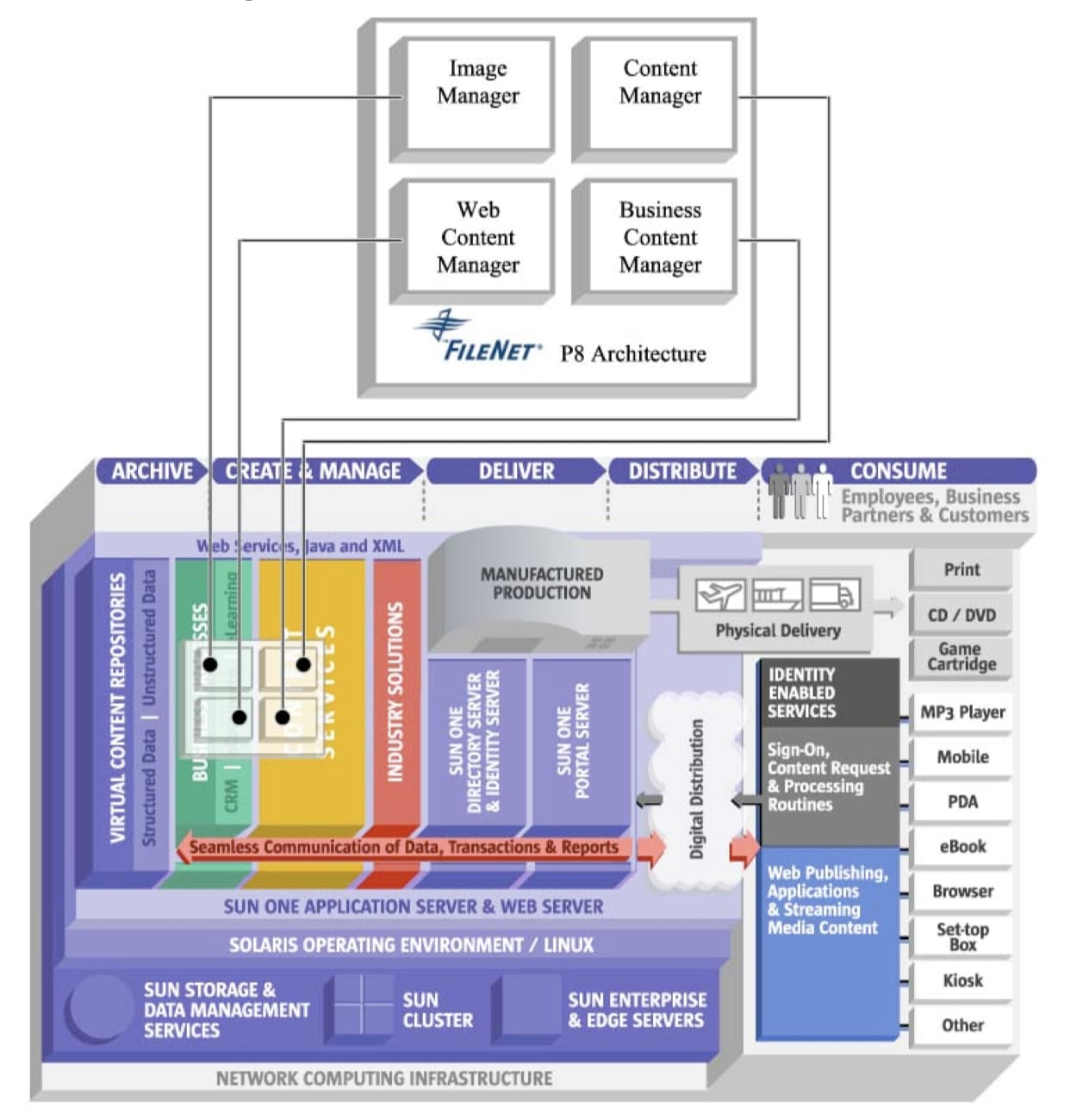Sebastian Holst, Senior Analyst, The Gilbane Group, March – July 8, 2003
Sponsored by Sun Microsystems
This paper includes 6 sections. The first section includes an overview the Sun ONE content services platform and a discussion of its applicability to financial services organizations in combination with Documentum’s enterprise content management (ECM) platform. The next 5 sections describe how each of Sun’s content management technology partners integrate with the Sun ONE architecture.
There are also links to individual partner PDF versions in the relevant sections below.
The Sun ONE Content Infrastructure Platform for the Financial Services Industry
You can also download a PDF version of this section (8 pages).
This paper presents the case for proactively developing a broad content strategy and architecture built upon a “content-capable” infrastructure. Optimizing operational efficiency, leveraging existing technology investments and investing in emerging business opportunities are among the many, often competing, demands on today’s businesses. The teaming of the Sun ONE Content Infrastructure Platform with the Documentum enterprise content management (ECM) platform presents an example that illustrates the benefits of an integrated architecture and advanced content management services.
Why an Infrastructure Approach?
Content Volume, Diversity, and Complexity
Today’s businesses are faced with an exponential growth in business content. Many companies have deployed enterprise content management systems to control, leverage, and reduce the cost of managing and delivering business critical content. The problem of managing enterprise content however, is too cumbersome for point-application solutions to solve alone. Businesses need to develop a comprehensive content strategy and architecture that is built upon a content-capable infrastructure.
The increase in the volume of content is only part of the problem. Content has become increasingly richer and more complex.
- Content is comprised of multiple data types sourced from disparate repositories and databases.
- The use of rich media content is growing, which adds new requirements is management functionality, bandwidth and storage.
- Businesses are learning the benefits (and difficulties) of more sophisticated use of metadata, which compounds the complexity of content.
Content in the enterprise includes a wide variety of formats, including structured database records, and unstructured text, graphics, audio, video and streaming media. There are a growing number of content application services, including web content management, document management, digital asset management, knowledge management, enterprise search and categorization, collaboration, and syndication that focus on managing either specific content types, or specific aspects of the enterprise content management problem. Many medium to large sized companies now have many of these content services in place, but while these provide important benefits, in most cases their real value is only realized when the content is integrated with larger enterprise data systems, and when a business has implemented disciplined, yet flexible, business process management.
The good news is that more business content is being managed; the bad news is the growing complexity of integrating and managing all of the systems that manage the content.
Content Accessibility & Integration
Most enterprise content is tightly integrated with one or more business applications (although that is not to say it is integrated with all appropriate business applications). Content plays a critical role in business processes ranging from customer relationship management (CRM), supply chain management (SCM), enterprise resource planning (ERP), business intelligence (BI), and other enterprise applications. In order for these processes to provide value, they must be able to incorporate the right data, in the right process, at the right time. Content often comes from diverse repositories across the enterprise and even between enterprises that have business-to-business relationships. Data exists in structured databases or may exist as unstructured data in numerous content repositories – from the desktop to back-up tapes. Furthermore, many companies already have one or more enterprise systems, and most companies need a strategy for extending the value of, and not replacing, those systems. Yet, there also needs to be a strategy that allows for a smooth migration to new systems when there is a need for technology change.
Not only is content complexity on the rise, but the integration required to make a content solution provide value for the enterprise has become a daunting challenge. Companies need a strategy that simplifies content accessibility and helps to manage this content complexity throughout the content lifecycle.
Content Services Infrastructure
The rise in content complexity means that businesses need to follow an infrastructure approach that enables content services throughout the enterprise. It means that IT managers need to deploy an architecture that ties content and content-based applications together in powerful yet flexible ways. The need to share and integrate content is broad based, and not limited to particular vertical or departmental applications. Therefore it doesn’t make sense to solve the problem only through individual integration efforts – a strategy that is based an infrastructure approach is the only way to meet this challenge head on.
Today, this means deploying a stack built on a network-computing infrastructure foundation. It also means an architecture that can support legacy applications, but is designed to optimize the use of web services for both content and application integration.
Sun ONE Content Infrastructure Platform
The Sun Open Net Environment (Sun ONE) Content Infrastructure platform in Figure 1 (Diagram courtesy of Sun Microsystems, Inc.) is an example of what we mean by an integrated infrastructure for content services. The figure illustrates the way business content and processes fit into infrastructure stacks both vertically and horizontally. This requirement for an integrated content services approach cuts across various industries such as manufacturing, retail, healthcare, government, media and entertainment, and of course, financial services.
Figure 1 is designed to show the range of solutions that Sun provides, from servers, storage and operating system, to application server, identity management, and portal technologies. On top of this network computing infrastructure Sun partner technology can be integrated into this modular architecture. This illustration also suggests how one could incorporate other component technologies into an integrated infrastructure. Note that if you think of an infrastructure in this way, light is shed on the relationship and scope of the components, which is very useful given the extensive functional overlap between many of the functional categories. It is important to understand the functions and features of the various components, so as to better able to make your own choices to match your business requirements, and to be able to substitute components with minimal effort, and cost.
One Architecture, Multiple Choices
Paradoxically, the one-to-many relationship between an architecture and the suppliers that populate that architecture is both the root of the value proposition, and often the cause of anxiety for businesses that must assimilate and build out that architecture. This anxiety often results in avoidance strategies that rely unnecessarily upon service-laden “one-stop” solutions at the high-end or simpler, more proprietary solutions at the low-end.
A compelling characteristic of the Sun ONE Content Integration Platform is that it provides an infrastructure that frees content technology providers to focus valuable resources on their areas of expertise by providing easy and reliable access to critical portal, networking and storage services. The following section illustrates the value of this approach by taking a closer look at the synergistic characteristics of the combined Sun ONE Content Integration Platform and the Documentum ECM platform.
The Documentum ECM Platform
Enterprise Content Management Platform Provides Real-Time Control over Enterprise Content and Documentation
Just as Sun has considered the complete solution as it delivers a “content capable” infrastructure, Documentum has also anticipated the broad requirements an enterprise will have in order to manage content throughout a customers’ own product lifecycle including design, manufacture, sales, marketing, customer support, and maintenance.
The Documentum architecture hosts and integrates each of its product components including web content, digital asset and compliance management. However, the value of Documentum’s architecture is that its approach ensures that their suite of components can leverage an infrastructure such as the Sun ONE Content Integration Platform.
Targeted Feature Functionality for the Financial Services Industry Clarifies Value Proposition and Speeds Adoption
A comprehensive content architecture that is built upon a content-capable infrastructure is by its very nature a generalized, scalable solution whose value stems from an ability to ingest, manage and distribute all kinds of content across the complete spectrum of use cases. Paradoxically, it is the generality, or horizontal design, that often makes specific applications and use cases difficult to evaluate and specify, and expensive and time consuming to deploy.
Financial professionals live in a world filled with funds, portfolios, trades, customers, regulations and reports. They do not think in terms of content infrastructure services. Generalized technology that has been embedded in specific applications targeting particular use cases is often simpler to cost justify, easier to deploy, and more valuable to the customer.
Documentum offers financial services applications designed to increase the value of their ECM services platform to financial service institutions. These solutions are intended to reduce expenses while addressing complex enterprise content management issues. Documentum’s premise is that, while financial services convergence has created many opportunities, it has also increased the importance of automation and increased the complexity of regulatory compliance. Further, each financial sector: insurance (and the multiple lines with-in it) retail, commercial and investment banking, continue to have unique content management requirements. With the goal of addressing both the broader integration issues and sector- specific requirements, Documentum has packaged their products and technology into four “solution suites:”
- Compliance and Regulatory
- Infrastructure Operations and Automation
- Client and Corporate Communications
- Banking and Insurance Operations
It is Documentum’s assertion that their solutions are more than enabling technology. They are prepackaged stacks that directly address a specific class of business problem. For example, one Compliance and Regulatory “solution suite” is designed to simplify SEC 17a (For the complete text of SEC 17a visit http://www.law.uc.edu/CCL/34Act/sec17A.html.) compliance as well as Sarbanes Oxley. The suite includes records management to address the SEC 17a regulations for “books and records” and for communications such as email and instant messaging. In addition to this, their collaboration features are offered to facilitate communication and coordination with internal and external auditors and counsel to create and implement business controls that are key to complying with Sarbanes Oxley (For complete text of the Sarbanes-Oxley Act of 2002 visit http://www.law.uc.edu/CCL/SOact/soact.pdf.).
Straight through Processing (STP): A Case in Point
According to SWIFT (the industry-owned cooperative that supplies secure messaging services and interface software), the lack of STP across the securities industry costs the industry $12 billion every year. This comes from the need to manually intervene as the record of a trade passes between systems from pre-trade to fulfillment.
To achieve STP, communications between the various parties connected to a trade need to be streamlined and the manual intervention in the trade process needs to be limited or completely removed. STP requires a comprehensive content architecture that is built upon a content-capable infrastructure such as the Sun ONE and Documentum solution.
STP minimizes manual handling and redundant processing which can be automated, leading to greater efficiency, as well as reduced cost and risk exposure. The value of this specialized version of a content infrastructure and service solution is easily measured in terms of
- Lower costs per trade
- Faster settlement time
- Better risk management and risk reduction
The trend of building commercially available specialized solution stacks built upon generalized infrastructure and content management services is extremely encouraging and is likely to become highly popular as customer successes are more widely understood.
Sponsoring Company
For more information, please visit http://www.sun.com or contact:
Sun Microsystems, Inc.
4150 Network Circle
Santa Clara, CA 95054 USA
For more information, please visit http://www.documentum.com or contact:
Documentum Inc.
6801 Koll Center Parkway
Pleasanton, CA. 94566
Vignette Content Suite & Sun ONE Content Services Platform
This section presents the case for proactively developing a broad content strategy and architecture built upon a “content-capable” infrastructure. Optimizing operational efficiency, leveraging existing technology investments and investing in emerging business opportunities are among the many, often competing, demands on today’s businesses. The teaming of the Sun ONE Content Services Platform with Vignette’s Content Management and Portal Solutions presents an example that illustrates the benefits of an integrated architecture and advanced content management services.
You can also download a PDF version of this section (7 pages).
The Vignette Content Suite
Full Function Content Management and Portal Solutions Deliver Business Process and Content Across the Enterprise
Vignette focuses its resources and talent on the management of content throughout their customers’ organizations, and to ensure that web-based interactions are personalized, meaningful, and add to an organization’s understanding of its business and the communities it serves.
The Vignette V7 architecture provides a services delivery foundation for its content management and portal offerings. The Vignette V7 architecture ensures that each of Vignette’s components work well together. However, a critical value of Vignette’s architecture is that its support for open standards including J2EE, XML and Web services allows that their suite of components to leverage components of a standards-based infrastructure such as the Sun ONE Content Services Platform.
A Case in Point: The Georgia Technology Authority (GTA)
Established by the Georgia legislature in July 2000, the GTA helps connect citizens to state government through information technology and ensures the effective use of IT resources. The GTA charter includes the development of a statewide technology plan and to oversee the purchase of technology resources. In the development of the state’s web site, www.georgia.gov, the GTA had a number of objectives including:
- The presentation of easy to understand, intention-based state information and services to Georgians, regardless of physical abilities, cultural backgrounds or language
- The availability of all public records, state information and Web-enabled services via the state government’s enterprise portal
- The ability to share information and processes between state entities
Sun Microsystem’s Sun ONE Content Services Platform and Sun ONE Portal Server 6 coupled with Vignette’s Content Management provided a content management backbone with a 24X7 portal that helped GTA to achieve their goals. Notable features and benefits included:
- Personalization improving service to Georgians
- Cost reduction achieved through simplified facilities management
- Greater agency independence from IT staff through simplified content contribution and review and a
- Consistent user interface across agencies reducing training requirements and improving navigation.
These changes resulted in a ranking in the top ten best of the web for eGovernment by Government Technology Magazine, the Center for Digital Government, Public Technology, Inc., and State Technologies in 2000. The fact that the respective product lines and architectures from Sun Microsystems and Vignette can be developed independently and deployed concurrently show that that large, complex and mission critical deployments can be built upon a modular technology stack. For more information on Sun ONE and Vignette in their own words, visit www.sun.com/vignette.
Further, the GTA case study shows how a solid, scalable content-driven infrastructure can effectively integrate key business processes, content services, and government agency industry solutions all into one system.
For more information, please visit http://www.vignette.com or contact:
Vignette Corporation
1601 South MoPac Expressway
Austin, TX 78746-5776
Documentum ECM Platform & Sun ONE Content Services Platform
This paper presents the case for proactively developing a broad content strategy and architecture built upon a “content-capable” infrastructure. Optimizing operational efficiency, leveraging existing technology investments and investing in emerging business opportunities are among the many, often competing, demands on today’s businesses. The teaming of the Sun ONE Content Infrastructure Platform with the Documentum enterprise content management (ECM) platform presents an example that illustrates the benefits of an integrated architecture and advanced content management services.
You can also download a PDF version of this section (6 pages).
Enterprise Content Management Platform Provides Real-Time Control over Enterprise Content and Documentation
Just as Sun has considered the complete solution as it delivers a “content capable” infrastructure, Documentum has also anticipated the broad requirements an enterprise will have in order to manage content throughout a customers’ own product lifecycle including design, manufacture, sales, marketing, customer support, and maintenance.
The Documentum architecture hosts and integrates each of its product components including web content, digital asset and compliance management. However, the value of Documentum’s architecture is that its open approach ensures that their suite of components can leverage an infrastructure such as the Sun ONE Content Services Platform.
For more information, please visit http://www.documentum.com or contact:
Documentum Inc.
6801 Koll Center Parkway
Pleasanton, CA. 94566
Interwoven Content Platform & Sun ONE Content Services Platform
This paper presents the case for proactively developing a broad content strategy and architecture built upon a “content-capable” infrastructure. Optimizing operational efficiency, leveraging existing technology investments and investing in emerging business opportunities are among the many, often competing, demands on today’s businesses. The teaming of the Sun ONE Content Services Platform with the Interwoven Content Platform presents an example that illustrates the benefits of an integrated architecture and advanced content management services.
You can also download a PDF version of this section (7 pages).
Interwoven’s Open Content Platform
A Code and Content management and Distribution Platform Improves Service, Accelerates Development and Reduces Cost
Interwoven focuses its resources and talent on the broad requirements an enterprise will have in order to manage content and code across their customers’ organizations and to ensure that the distribution of this code and content across multiple outlets is secure, accurate, timely and personalized.
The Interwoven Platform consists of four primary components; Content Integration Enterprise Repository Connector Suite, TeamSite Content Management, MetaTagger Content Intelligence, and OpenDeploy Distribution Server.
These four primary components combine to manage of a wide range of content:
- Content Management for Portals: Business users maintain content control, facilitate portal adoption, and place searchable content onto portals.
- Collaborative Document Management: Simplify document management, collaboration, and the sharing of work.
- Media Asset Management: Enforce brand control across channels, reduce production and access complexity and provide marketing automation across an organization.
- Web Application Management: Provide content and code management in a single environment.
- Web Content Management: Create, manage, and deploy content to web sites.
- Content Management for CRM: Integrate unstructured enterprise content with structured customer information.
A Case in Point: The American Hospital Association
The American Hospital Association, founded in 1898, has a mission to advance the health care of individuals and communities by leading, representing, and educating health care provider organizations that are accountable to the community and committed to improving healthcare. AHA members include nearly 5,000 hospitals, health care systems, networks and other care providers and over 37,000 individual members.
The American Hospital Association (AHA) faced a classic problem: affiliate information was spread out over multiple sites, administered by different managers on a variety of different operating platforms. AHA conceived of a unique type of portal to solve the complex content publishing and distribution issues that its members faced. The group used an enterprise-wide content management and delivery solution from Interwoven and Sun Microsystems to consolidate material from 50 disparate websites and reinvented the way that it supports, educates, and represents the interests of hospitals and healthcare providers.
The AHA solution, HospitalConnect.com, is built upon the content management and distribution products from Interwoven and the Sun ONE Content Services Platform. The resulting benefits of centralized management and automated content submission and distribution workflows across their entire affiliate community included increased operational efficiencies, a more productive workforce, better-organized content, and improved patient care.
Diagram courtesy of Interwoven, Inc.
Some specific characteristics of the AHA solution include
- Affiliates and staff contribute and manage files directly from existing word processing and desktop applications.
- Users can convert content into form-based XML data
- Collaborative users can add “sticky notes” to content directly from their browsers.
- Users can browse and review content as it appears throughout the portal and related websites.
- Users can access content management tasks within an existing email system so that content can move quickly through the approval process.
- Users can automatically distribute material to the HospitalConnect.com portal and AHA affiliate sites.
One advantage to Interwoven’s architecture is that its open approach ensures that their suite of components can leverage an infrastructure such as the Sun ONE Content Services Platform.
The fact that the respective product lines and architectures from Sun Microsystems and Interwoven can be developed independently and deployed concurrently is a positive indication that large, complex and mission critical deployments can be built upon a modular technology stack.
The American Hospital Association case study shows how a solid, scalable content-driven infrastructure can effectively integrate key business processes, content services, and healthcare industry solutions all into one system.
For more information, please visit http://www.interwoven.com or contact:
Interwoven, Inc.
803 11th Avenue
Sunnyvale, CA 94089 USA
My Yahoo! Enterprise Edition & Sun ONE Content Services Platform
This paper presents the case for proactively developing a broad content strategy and architecture built upon a “content-capable” infrastructure. Optimizing operational efficiency, leveraging existing technology investments and investing in emerging business opportunities are among the many, often competing, demands on today’s businesses. The teaming of the Sun ONE Content Services Platform with My Yahoo! Enterprise Edition illustrates the benefits of an integrated architecture, advanced content delivery services, and premium content.
You can also download a PDF version of this section (7 pages).
My Yahoo! Enterprise Edition
Familiar Content Tools and Premium Content Drive Adoption of Corporate Portals
My Yahoo! Enterprise Edition is designed to add value to corporate portals through premium content and familiar content applications such as Industry News and Financial information to accelerate adoption and build employee, partner and customer loyalty.
One advantage of the Sun ONE open approach is that Sun and Yahoo! have been able to embed My Yahoo! modules in the Sun Portal to provide an entry point to this combined offering that requires very little effort and is simple to administer.
If You Build It, Will They Come?
A technology Return On Investment (ROI) cannot be achieved without the adoption of both the technology and user behaviors that the technology was intended to facilitate. Given Yahoo!’s 72% reach into the workplace (NetRatings, January 2003); many corporate employees are frequent and dedicated Yahoo! users. By bringing Yahoo! content and tools inside the corporate portal, companies can dramatically increase portal usage and frequency. When employees go to the company portal to check their Yahoo! information, they maybe more likely to stay and use the other portal resources.
Beyond the reasonable assumption that users will tend to gravitate to portals that offer the most complete and integrated set of services, the personalization modules from My Yahoo! Enterprise Edition that are embedded in the Sun ONE Portal provide a means for portal administrators to serve specialized content “in context.” For example, a financial services portal can feature banking self-service applications, surrounded by content feeds related to money management.
In this infrastructure and content offering, Sun and Yahoo! offer a unique pairing that should increase user demand for Sun ONE-based portals and open new markets for Yahoo! content services.
For more information, please visit http://enterprise.yahoo.com or contact:
Yahoo! Inc.
701 First Avenue
Sunnyvale, California 94089
FileNet Business Process Manager & Sun ONE Content Services Platform
This paper presents the case for proactively developing a broad content strategy and architecture built upon a “content-capable” infrastructure. Optimizing operational efficiency, leveraging existing technology investments and investing in emerging business opportunities are among the many, often competing, demands on today’s businesses. The teaming of the Sun ONE Content Services Platform with FileNet’s Business Process Manager presents a solution that illustrates the benefits of an integrated architecture and advanced content management solution.
You can also download a PDF version of this section (7 pages).
The FileNet BPM Solution
Business Process Management across the Enterprise
Just as Sun has considered the complete solution as it delivers a “content capable” infrastructure, FileNet has also anticipated the broad requirements an enterprise will have in order to manage content throughout their organizations and to effectively automate and streamline business processes.
FileNet’s P8 offering is differentiated by its Business Process Management capabilities, which include integrated process simulation, reporting and analytics. The FileNet P8 architecture features four pre-packaged suites including the Business Process Manager suite, designed for applications that automate complex business processes to improve process performance and reduce cycle times. FileNet’s real time and historical tracking of these processes combined its process analysis and simulation capabilities place a premium on utilization of resources and process optimization.
FileNet’s P8 architecture hosts and integrates each of its enterprise content management offerings including its Business Process Manager, Content Manager, Web Content Manager and Image Manager as shown below. The standards-based FileNet P8 architecture ensures that each of FileNet’s ECM components work well together. In addition, FileNet’s approach ensures that their family of ECM offerings can leverage an open systems, network infrastructure like the Sun ONE Content Services platform.
A Case in Point: The State of New Jersey Division of Revenue
The State of New Jersey Division of Revenue processes tax returns and payments from New Jersey taxpayers totaling more than 8.5 million total returns and remittances each year. Prior to deploying the Sun and FileNet image-enabled processing system, the cost to the state and its citizens included a combined permanent and seasonal staff of 700 and mounting delays in revenue collection. The “heads down” method of processing returns increased repetitive strain injuries resulting in increased medical expenses, lost time and lawsuits.
Today, the Division of Revenue’s image-enabled processing systems handle in excess of 1 million pages per day during peak periods, while more than 250 users in seven state agencies retrieve more than 23,000 documents each day. Taxpayers now receive more timely responses to their inquiries and, on average, are sent their refunds one week earlier. Seasonal staffing and tax processing costs have both been reduced by 50 percent and storage costs have been cut in half.
The State of New Jersey success story is powerful for a number of important reasons. First, in order to achieve their objectives, legacy technology and practices (processes) had to be upgraded simultaneously. Second, the sheer scale and time-sensitive nature of the project illustrates how critical it is to be able to build on a broad and deep architecture that facilitates complex integrations of technology components and workflows.
The fact that the respective product lines and architectures from Sun Microsystems and FileNet can be developed independently and deployed concurrently can be seen as a positive indication that large, complex and mission-critical deployments can be built upon a modular technology stack.
Further, the New Jersey case study shows how a solid, scalable content-driven infrastructure can effectively integrate key business processes, content services, and government agency industry solutions all into one system.
For more information, please visit http://www.FileNet.com or contact:
FileNet Corporation
3565 Harbor Blvd.
Costa Mesa, CA 92626-1420 USA
